Holding binoculars steady is an essential part of birding, wildlife watching, and stargazing. If you can master this skill, you’ll be able to see more detail in your sightings –no matter how far away your subjects are. But how to hold binoculars steady this is the million-dollar question!
Few quick tips if you don’t want to read the whole article about how to keep binoculars steady:
- Use both hands to stabilize the binoculars.
- Hold the bino in the middle of each barrel for terrestrial viewing (for land-based animals). For celestial views, hold it close to the eyepiece (for stargazing)
- Keep your arms close to your body, with your elbows bent close to each other, and your shoulders should be straight – this will help prevent shaking while watching wildlife or gazing at starry skies!
- If you’re using a strap to keep the binoculars stable, make sure it’s tight around your biceps and elbows, so they don’t move around too much when you look through the eyepieces (or use a waist belt if you have one).
- Get elbow support from your surroundings. This will help keep your arms stable, preventing them from shaking while you’re looking through the binoculars.
- Sit or lay down if your legs become shaky for prolonged standing.
- Hold your large bulky binoculars single barrel with both hands for extra stability.
- Place your bino on a solid surface if you find any opportunity nearby.
- If you can carry a monopod, tripod, or Parallelogram Mount, using them will give you extra stability.
- If you find that your arms are shaking excessively, then it may be a good time to take a break and come back later when the adrenaline has dissipated.
- And finally, remember: practice makes perfect! Experiment with different hand positions and angles until you find what works best for you. So go out and start viewing the world with steadier hands – you won’t regret it!
Many people think that holding binoculars steady is easy, but it can be pretty challenging in reality. This is because the natural motion of our arms and body while looking through high magnified binoculars creates the “image shake” problem that affects our observations’ clarity.
Several factors can contribute to image shaking when looking through binoculars. It takes some practice to get them under control. First, let’s find out the root of the problem, why holding binoculars steady is challenging and what the heck is image shake, and how can you avoid it?
What is image shake in binoculars?
The image shake problem in binoculars refers to the instability of images seen through the eyepieces, making it difficult to see clearly. For example, let’s say you are breathing fast due to the strenuous hike and your arms are shaking a bit. This tremor will also be transmitted to the binoculars and amplify greatly with magnification causing the image to shake.
This is why you may find it difficult to see clearly at high magnifications when using binoculars – due to image shake.
Image shaking problem is highly correlated with magnification and unstable body movement. Image shaking, increases in proportion to the magnification of binoculars.
Think of your smartphone camera as a binocular. When you zoom in at its maximum level and want to take a picture of an object, you will notice the field of view becomes narrower, and it’s hard to keep the image still. Because a tiny movement of your hand or heavy breathing will create a big movement in the magnified optics. Zooming out on the smartphone camera, you will notice less image shake for the lower magnifications level. Also, there is much more room to move around within the photo.
Binoculars are no different, and this is why you may experience difficulties when trying to focus on distant objects at high magnification levels.
Now Let’s Learn How To Hold Binoculars Steady And Avoid Image Shake?
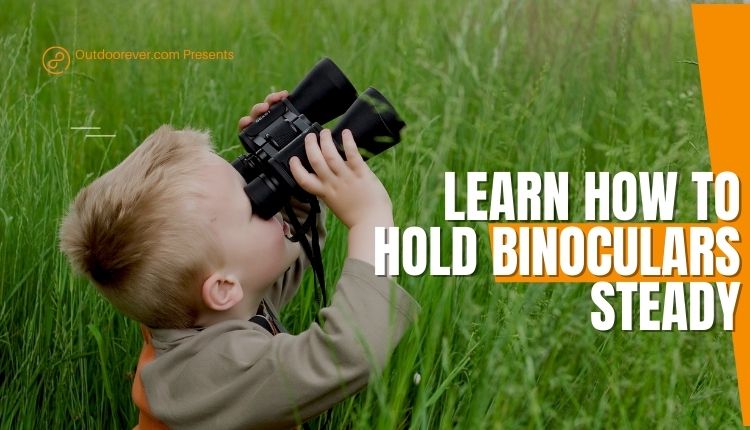
For a keen observer, binoculars are nothing short of essential for critical observations. Unfortunately, the slightest shake or blur can easily obscure the view. But the good news is you can be just about any age and still adopt new techniques discussed here.
In this article, you will learn, from holding binoculars steady to what a person should do to improve their skill.
There are many ways to keep binoculars steady, and the best way for each person is different. These 15 tips will provide basic information on holding binoculars steady, but be sure to experiment with these techniques and find what works best for you.
The tips and tricks presented here will help you take a lot of benefits. Going by these best practices will make sure you can control your binoculars more effortlessly and hold them steady when you need to. In addition, once you have learned all these things, you will be able to enjoy your viewing experience even more.
Take a Deep Breath And Relax
It is very important to take a deep breath and relax your hand muscles before holding the bino. This will help you tremendously to hold binoculars steady. Also, being relaxed will help you stay as still as possible while keeping the glasses in focus.
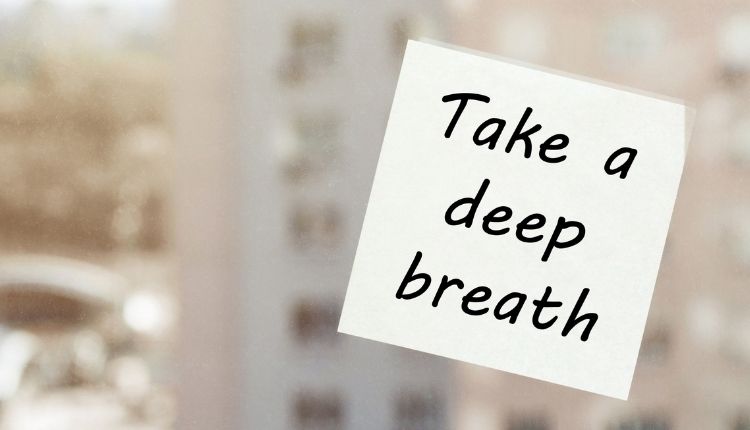
To do this, take a deep breath through your nose and hold it for a few seconds. After taking the breath, let it out slowly and deeply through your mouth. When doing this, keep in mind your shoulder should be relaxed, and your abdominal muscles should expand. Repeat This Breathing Exercise Several Times if you feel Unsteady.
It is also important to remember to exhale slowly when holding your binoculars. When you do this, it will help dissipate any energy that might be causing the glasses to shake.
Hold Your Bino Gently
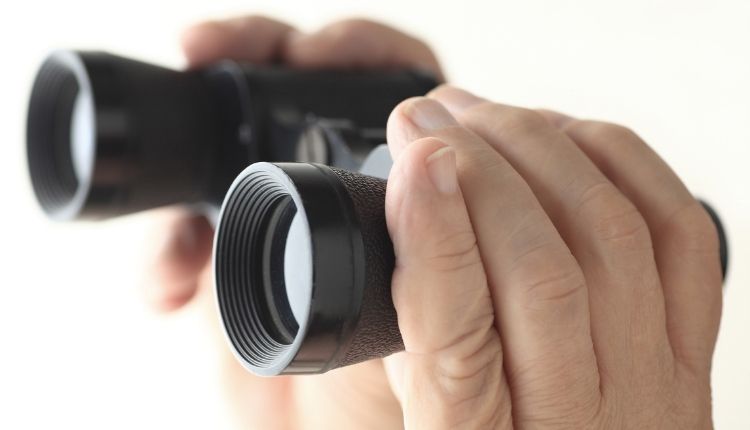
A quick tip to reduce image shake is not holding binoculars tight or firmly. Holding binoculars firmly will transmit your little body shake to the glasses. So instead, try to hold them gently to make the shakiness less noticeable.
Check the Eyecups are Properly Adjusted
Make sure the eyecups are correctly adjusted. If your eyes feel strained when looking through the binoculars, it means that the eyecups are not in the proper position and can cause more shakiness. Longer eyecups and more space between the eyecups and your eyes create a shaky image. Even most of the recent binoculars for less than 200 dollars come with twist eyecups that make it easier to adjust the eyecups.
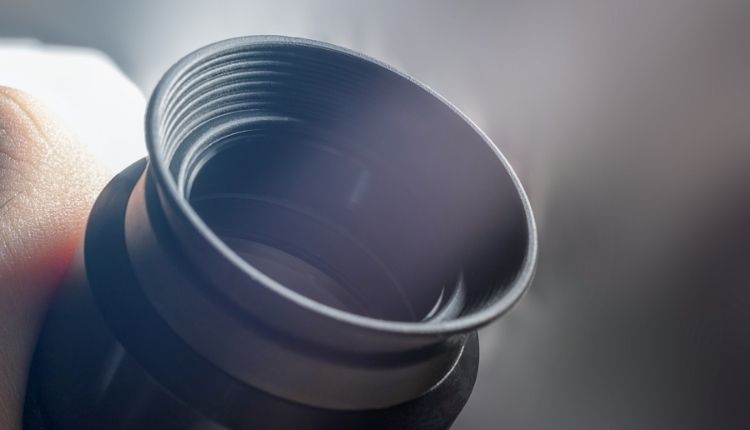
Use Your Both Hands To Hold Your Binoculars
Many beginners often make the big mistake of holding their binoculars with only one hand. Doing so makes it very difficult to keep the glasses stable and causes them to shake. This is why it is always essential and the number one rule to have a steady image is to use both hands when you hold the bino.
Make a Triangle Posture With Your Arms:
One of the most important and easiest things a person can do to improve their binocular skills is to properly use their hand, muscles, and body structure. When you use both your hands, always keep the upper arms and elbows as close as possible and relaxed.
If you see the below image, the eyecups, upper arms, shoulder, and elbow create a triangle shape, often called a triangular arm brace. This triangle posture will help stabilize your hand and binoculars, making you less likely to shake during the viewing process. As a result, you will get steadier images and improved viewing clarity than holding the bino in one hand. In addition, when you hold the bino as the triangle below, it will help position your neck and spine correctly to ensure good binocular vision.
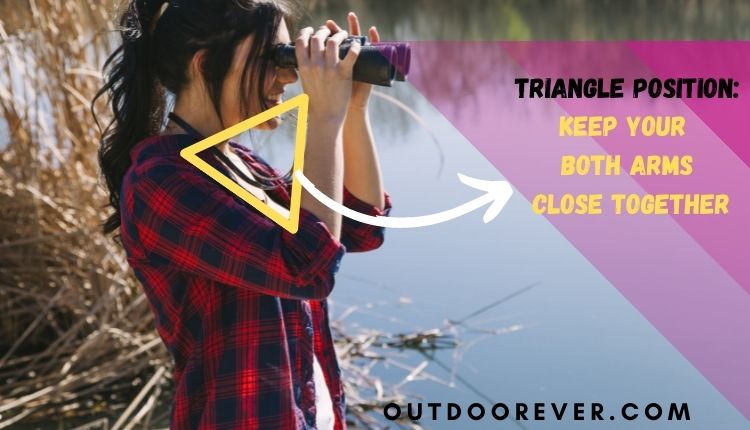
Hold Bino In The Middle Of Each Barrel For Terrestrial Object:
Most of us hold binoculars in the middle, one hand on each tube, for reaching the focusing wheel quickly. This is okay and a good idea to grab binoculars for bird watching or terrestrial objects. For better stability, just make sure you apply the rule of triangle posture to your hands and body, as mentioned above.
Hold Bino Close To The Eye Piece of Each Barrel For Celestial Object:
But when you use this holding technique for looking at celestial objects for a prolonged time, it can quickly tire your arms. For example, let’s say you are always used to holding bino in the middle of each barrel now; suppose you are out for viewing the night sky with your friend; holding the bino in the middle will surely tire your arms after a while.

To improve your prolonged use for an upward viewing experience and to less fatigue. It is advised to try using both hands close to the eyepiece when holding binoculars. This will provide more stability and help evenly distribute the force applied to your arms. And since your thumb and forefinger will be resting on your face, stray light will not affect the image as much.
Use a Waist Belt Or Binoculars Strap For Extra Stability
Stargazing can be a great way to have fun and learn about the universe. However, it can also be a strenuous activity since you need to bend your neck and look upwards for a long time. Therefore, while using binoculars for astronomy or stargazing, it is important to ensure that you use the right technique and equipment to achieve precise and sharp images of those dim stars in the sky.
One way to improve your viewing experience is to use a strap around your upper arms. This will help you keep the binoculars in a stationary position and prevent them from shaking. Some outdoor people name this the rifle sling method. However, the technique is quite straightforward.
First, make a circle by buckling the waist belt. Then, put the strap around your upper arms just below your shoulder. Now, look upwards with your bino, and then when you stretch out both arms, you feel the arms got stable support at the maximum point of the loop of the belt.
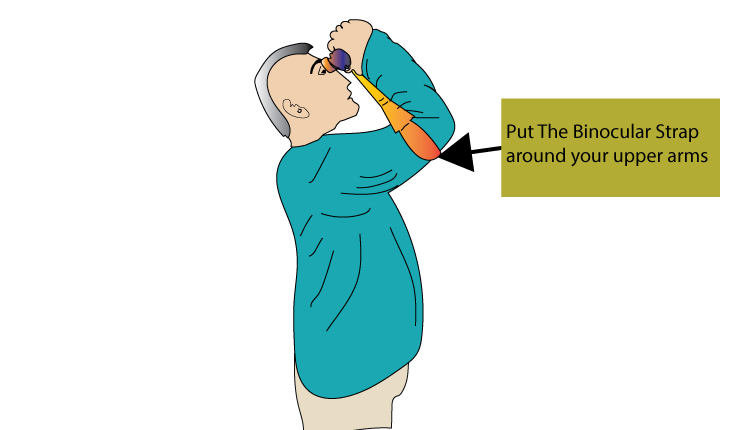
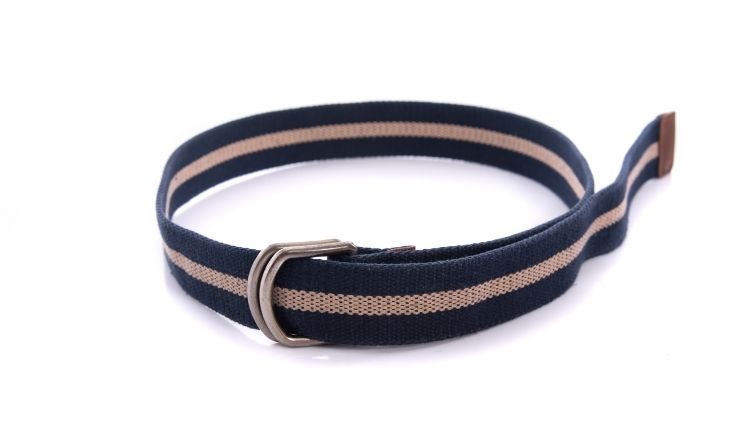
You can use similar techniques with the binocular straps, but it’s dangerous to drop the binoculars accidentally. So to me, the waist belt is the perfect solution to keep the hands stable simultaneously; the bino strap does its own task.
Double-Handed Stabilizing Method:
Oftentimes using large and heavy binoculars can be tiring and unstable, so here is another stabilization method. This one uses both hands to stabilize a single barrel of binoculars. First, you have to identify which eye is your dominant eye to apply this method.
If you are a left-eye dominant person, first create the triangle shape using your left hand and then hold the left objective barrel with your right hand. Here remember the side of the eyepiece should hold with the hand of the dominant eye side. So in the above case, if you are a left-eye dominant person, hold the eyepiece side with the left hand, and the objective lens side should be with the right hand of the same barrel of the bino.
Hold bino wearing Baseball Cap Or Other Cap:
In this technique, we gonna take extra support from a ball cap Or Other cap. To do that first:
- Wear a baseball cap or any other cap, which must be with a stiff brim.
- Hold the binoculars in your hands like you would if viewing with them.
- Grab the brim or peak of the cap, hold it in place, and place the bino in your eye.
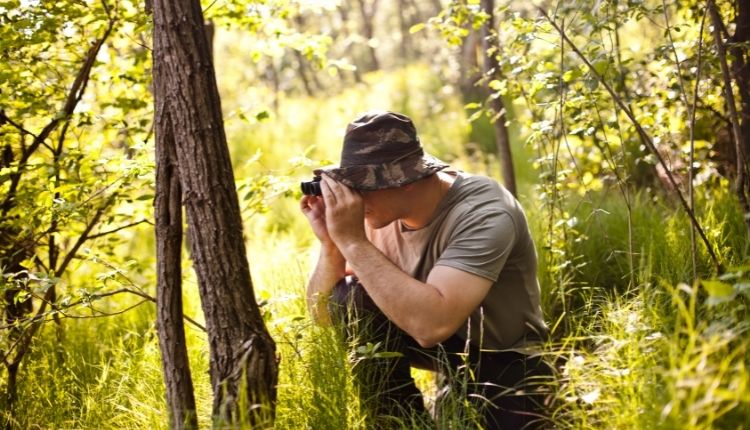
This will help keep them stable and prevent them from shaking while you view them. However, this method is not perfect for long binoculars and may work better with roof prism housing or compact binoculars. To access the center focus wheel, make a small hole in the cap’s brim.
Give Support To Your Elbow:
Mounting your binoculars to a tripod is the best solution to get the most clarity in your views. However, if you find that your elbows are beginning to fatigue after extended periods of viewing, try using a monopod or tripod for added elevation or an extension arm to support your arms.
But the major disadvantage of using a tripod and monopod is the restriction of your mobility. It might be more challenging to take your tripod with you if you are touring or hiking.
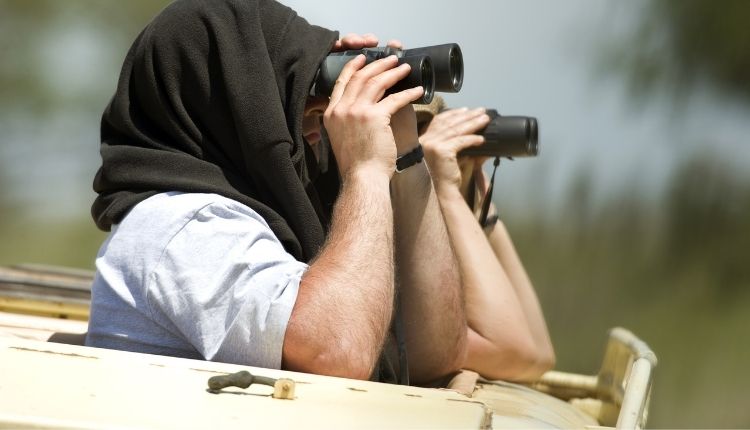
If using a tripod is not an option, try to take support from your surroundings. Try to be creative. Find some solid support where you can lean your elbows on, such as a rock or wall, railing, and others. This elbow support is essential for battling fatigue. When I use my best binoculars for deer hunting from the ground blind for bowhunting, I usually take support from my backpack, keeping it on my legs if I don’t find solid anything nearby. Also, try to adjust your viewing position often. This will help avoid any long-term fatigue in your elbows.
Use Reclining Chair For Prolonged Stargazing:
If you can find a foldable reclining chair, it is a great way to prolong your enjoyment of stargazing. Lying down allows the neck and spine to rest in an extended position, reducing fatigue. Additionally, since some reclining chairs typically have adjustable headrests, you can easily change your viewing angle to optimize clarity. Keep remembering a reclining chair not only provides comfortable support but also limits your mobility. So, this is an excellent solution for those who want to stay longer in one spot and see more stars.
Use foldable stool/chair or sit down on a solid surface:
Standing for an extended period can cause many health complications, including issues like:
- Exhaustion and fatigue;
- Leg cramps;
- Backache;
- Excess pressure on the joints.
Indeed the above problems are severe, and any one of them starts appearing when you are in prolonged glassing. This can tremble your balance and make the situation even worse. So, what can you do to hold your binoculars steady and avoid those health issues?
To avoid these problems, you should take a break and sit down. That’s where foldable stools or chairs come in handy. By using one, you can rest your feet while keeping your hands free to hold the binoculars steady.
These types of stools/chairs are lightweight and easy to carry around and fit even in limited spaces. So you can take them with you and use them wherever you go.
Alternatively, if you don’t want to carry a stool for some reason, consider using a solid surface like the ground. Sitting down on this will help distribute your weight more evenly and reduce the chances of experiencing any problems, as mentioned above. Also, by sitting down from time to time, you’ll help keep your body and mind fresh.
Set The Binoculars On Hard Surface
Suppose you forget or don’t love to carry a tripod, monopod, or parallelogram mount. In that case, you can set the binoculars on a stable surface without using any fancy equipment. While you are observing in an open space outdoors, you can place one of the objectives of your binoculars on a rock or some other hard object. Doing this will significantly reduce the chances of your binoculars becoming unsteady, thereby minimizing the likelihood that you will experience any pain or fatigue in your hands. As a bonus, this simple technique can help you better focus on what you observe.
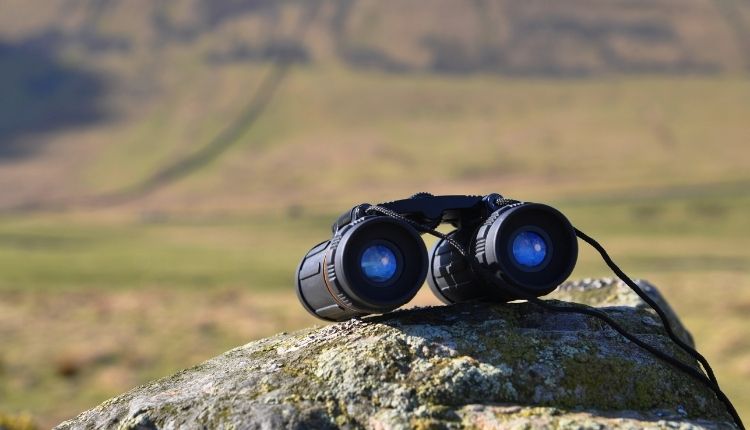
Use Monopod, Tripod, or parallelogram mount
Learning the tricks of how to hold binoculars steady without a tripod can be tricky and sometimes unrealistic. For example, as age increases, our balance and coordination may worsen, leading to instability. Also, the ability to steady one’s hands and fingers may diminish for many reasons. In that case, it can be helpful to use a monopod, tripod, or parallelogram mount to stabilize the binoculars.
Moreover, using them does not mean you cannot hold binoculars steady in bare hands. It’s actually a requirement. Just for the portability issue, we had to force ourselves to learn the above tips and techniques of how to keep binoculars steady and stabilize them when we were traveling and shooting landscapes or in different use cases.
These supportive legs will allow you to get closer to your target and keep the binoculars more stable than if you were holding them alone.
Monopod For Added Elevation
The monopod is one of the simplest and most common binocular stabilization tools. It’s basically a long, stick-like device with a mount on top. You can use it to hold your binoculars at any length or height, making it a good option for viewing landscapes or wildlife in open spaces. Monopods are lighter than tripods and easier to carry around, but they’re also less stable than tripods. To keep your binoculars steady on a monopod, you’ll need to find a sturdy surface to rest them on for the added elevation.
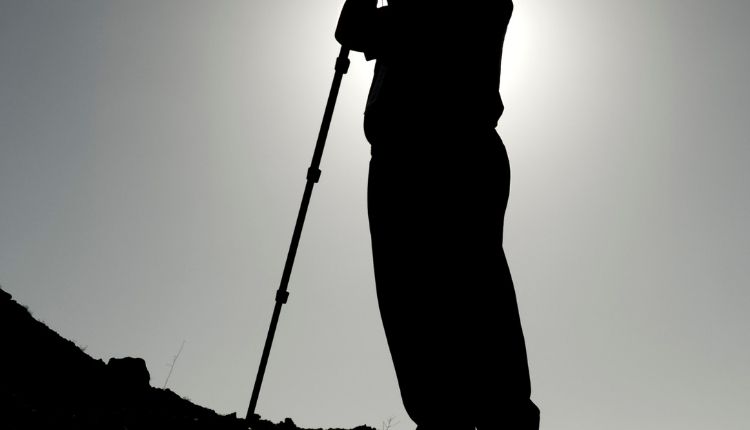
However, monopods have one significant limitation: They don’t stand on their own. Instead, you’ll need to hold onto the monopod for stability.
Tripod:
For better stability than a monopod, use a tripod for your binoculars. Tripod comes with three legs that can be spread out to provide a stable platform. When mounted on a solid surface, it also allows you to pan and tilts your binoculars while keeping them at the same height. Once you focus the bino properly, you are all good to view the sharpness and detail of the subject. Tripods are a bit heavier and bigger than monopods. Still, they come in various sizes, so you can find one comfortable for your situation.
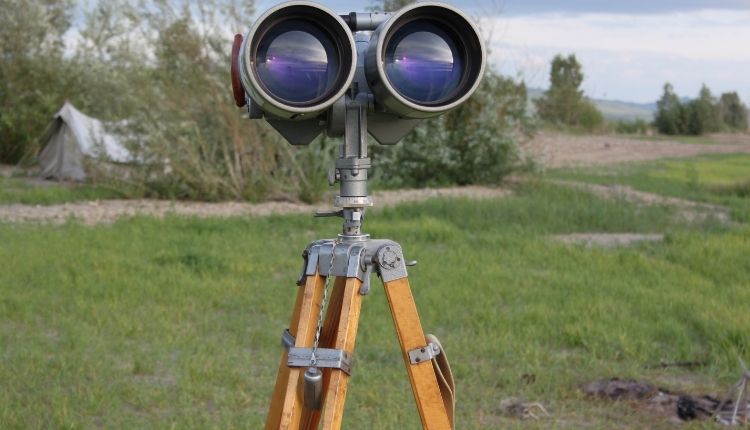
Parallelogram Mount:
A Parallelogram Mount is a type of tripod that offers stability and flexibility when observing. Parallelogram mounts provide a variety of advantages to amateur astronomers. They allow the height of the eyepieces to be changed without changing the target object, offering a good deal of versatility. In addition, you can adjust the bino or telescope to any height without re-level the tripod. Parallelogram mounts also provide a level of stability not found in other types of tripods. In addition, the parallelogram mount allows for quick and easy movement of the telescope.

For getting a steadier view with your binoculars, you can try using a parallelogram mount. This type of mount is shaped like a cross and attaches to the barrel of your binoculars by way of two screws. It creates an angle between the eyepieces that eliminates arm strain and shakiness.
Use Straps
A strap is a must for binoculars. They help hold your binoculars and keep them steady while looking through them. To get a steady view using a bino strap, follow the steps:
Your binoculars should be anchored to your torso through the straps that go around your shoulders. When holding the binoculars to your eyes, you need to push out the binoculars. This push-out creates tension on the belts, so they stay anchored to your torso.
Binopod/ Chest Harness:
While using binoculars for birdwatching or wildlife viewing, a binopod chest harness is a great way to steady the optics and free up your hands. These harnesses strap around your chest and neck, holding the binoculars in front of your eyes so that you can view without having to use your hands. Binoculars can be a bit fickle, and keeping them steady can be a challenge on your own. With binopod chest harnesses, you don’t have to worry about that – the harness securely holds the binoculars in place.
However, in real cases, you are eliminating your hand movement altogether, binoculars become a little more stable. But that’s doesn’t promise you are out of your body to shake. So for me, a tripod or more expensive Parallelogram mount is the best way to hold binoculars steady and get the freedom of movement.
Which Magnification Level is most Difficult to View Clearly?
In general, the lower the magnification, the less severe the image shake problem will be. Most people find it easiest to view distant objects with barehand at around 4x to 8x magnification levels. The shaking problem becomes more pronounced when you choose something 10x or above.
Few tricks to choose magnification levels that work best for you
- Try to choose binoculars with Image stabilization which will help slightly to reduce image shake. You will find such technology in the best rangefinder binoculars.
- If you are new to using binoculars, it is recommended to start off at lower magnification levels and work your way up as your skills develop.
- You can also use zoom binoculars; these types of binoculars have a wide range of choosing magnification levels. So you can always find the magnification that is comfortable for you.
- Finally, make sure to practice using your binoculars frequently to get more used to their movement and feel. This will help you learn how to control image shake in those moments when you really need an edge on your viewing.
How do Magnification and Objective lenses work? And How do they Impact On Producing Shaky Images?
Magnification works by using a lens to enlarge the object being viewed. If you take your bino out, you will notice two numbers imprinted; 8×42 or 10×50 or anything. Where anything before the x is the magnification number. That number tells you how many times the actual size image will be enlarged on the eyepiece when viewing through the binoculars. So 8x means the image will be eight times its original size on the eyepiece. 10x means it will be ten times and so forth.
The objective lens is used to gather more light onto the imaging device, particularly the prisms that are part of your binoculars. The larger the objective lens, the more light will be collected to see things in low light.
Magnification and the objective lens size are two main factors contributing to image shake. Higher magnification levels result in more movement within the optics even with slight body movement, making it harder to keep the object in focus. Additionally, larger objective lenses increase the overall weight of the binocular, which can lead to fatigue if used for a prolonged time. And If you are not comfortable holding the binos for its heavyweight, you are more likely to experience image shake.

About The Author:
Lake Streeter, A Gun enthusiast, and loves to hunt in the middle of the wood. Always check the latest hunting gears out in the market and try to share his honest opinion with the audience in Hunting Nook.
